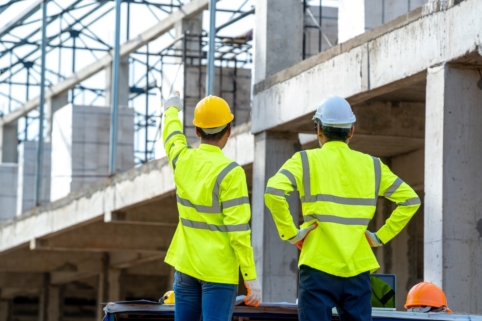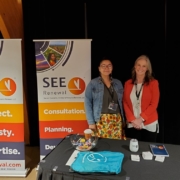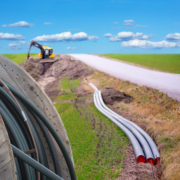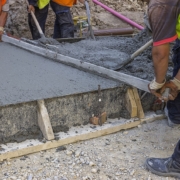Tribal Infrastructure Series
United States Committee on Indian Affairs Roundtable
Understanding the Blueprint
Our Tribal Infrastructure Series is based on a roundtable session hosted earlier this summer by the United States Senate Committee on Indian Affairs. The roundtable, “Concrete Solutions: Building a Successful Foundation for Native Communities’ Infrastructure Development,” initiated a thoughtful conversation between tribal and federal leaders and other key stakeholders about infrastructure needs from the tribal perspective.
The panel included the following participants:
- Mr. Anthony “Morgan” Rodman, Executive Director, White House Council on Native American Affairs, Washington, D.C.
- Mr. Jason Freihage, Deputy Assistant Secretary of Management, Indian Affairs, Department of the Interior, Washington, D.C.
- The Honorable Janet Davis, Chairwoman, Pyramid Lake Paiute Tribe, Nixon, NV
- The Honorable David Flute, Secretary, South Dakota Department of Tribal Relations, Pierre, SD
- Mr. William Aila, Jr., Chairman, Department of Hawaiian Homelands, Kapelei, HI
- Mr. Anthony Walters, Executive Director, National American Indian Housing Council, Washington, D.C.
- Ms. Carol Gore, President & CEO, Cook Inlet Housing Authority, Anchorage, AK
- Mr. Godfrey Enjady, President, National Tribal Telecommunications Association, Chandler AZ
Key points of the conversation included:
- Chronic shortcomings of the federal government in its relationship with tribal nations;
- Responsibilities and obligations of the United States to tribal governments;
- Unequal funding;
- Regulatory and programmatic barriers that make it extraordinarily difficult for tribal nations to gain the resources they need to improve on-reservation communities, grow tribal economies, and secure a competitive advantage against outside jurisdictions.
Just as a blueprint transforms the ideas of architects and designers into visuals and exhibits high-level details by showing the different components of the structure to be built, the roundtable dialogue has served as the starting point for the Tribal Infrastructure Series.
Key Takeaways
Designing the Floorplan
The Tribal Infrastructure Series is designed to closely explore the key takeaway points from the roundtable. Like the floor plan of a structure that focuses on the internal layout of a building and provides the reader with a detailed view of the different room types, sizes, shapes, and overall circulation between rooms, the key takeaway points serve as a guide for what is to come.
Key Takeaways
- Access to and reliability of broadband networks;
- Bureau of Indian Affairs (BIA) Rights-of-Way (ROW) permission as cumbersome and desensitizing investment;
- Need for water wells and waterlines;
- Infrastructure as directly related to housing and the economy and the need for flexible funding and localized solutions;
- Intensified natural disasters compounding already bad infrastructure and placing additional burdens on tribal communities;
- Education, training, and planning needed.
Defining Infrastructure
Laying the Groundwork
Since it has been made clear in the first installment that the purpose of the Tribal Infrastructure Series is not to engage in the infrastructure debate, but rather to evaluate current issues and topics related to infrastructure in Indian Country, we need to define infrastructure for the purpose of this series. To that end, we present a three-part definition that will serve as the groundwork or foundation for the series.
For this series, we will focus our discussion of infrastructure on:
- Physical networks or systems that link services and commodities to the end user;
- Physical and organizational components or the various parts that go into a network or system to make it work;
- Societal needs, here described as a set of priorities and expectations shared by large social groups that can be referred to on the tribal, regional, or national scale.
Exploring the Takeaways
Building the Framework
While the key takeaways serve as the floor plan or overall layout of the series, the dialogue behind each takeaway point serves as the overall framework or structure for the Tribal Infrastructure Series as a whole. The ideas explored below are intended to provide an overall structure for understanding the status of infrastructure in Indian Country and will serve as the starting point for each subject area or topic that we will be discussing throughout the remainder of the series.
1. Physical Networks
Broadband
Federal and tribal leaders have expressed the need for tribal communities to access broadband communications and have acknowledged that the COVID-19 pandemic further compounded this particular situation. There was consensus among stakeholders that internet access is not a “luxury” but rather a necessity for learning, working, and growing competitive economies. Mr. Godfrey Enjady of the National Tribal Telecommunications Association noted that the geographic positioning of most nations makes connectivity and reliability difficult and create ongoing problems that many tribal nations struggle with. Mr. William Aila, Jr., Chairman of the Department of Hawaiian Homelands, suggested a greater need for equitable tax credits to incentivize the private market to engage in broadband and other infrastructural development in Indian Country.
Federal notes: When asked about the status of broadband in Indian Country, Mr. Jason Freihage, the Deputy Assistant Secretary of Management, Indian Affairs, explained that the Interior Department has looked at tribal lands and accessibility on a high level, but that they need to engage with tribal leaders to better understand their tribal goals before the Department can determine how to go about assessing their needs. Mr. Freihage also noted that all but two Bureau of Indian Education (BIE) schools have the “minimum level of broadband.” He acknowledged that the challenge lies in getting the service to the home and the family. Chairwoman Davis of the Pyramid Lake Paiute Tribe emphasized the need for access to residential services. She expressed that many of her nation’s children are bussed outside of the reservation, and that this arrangement further hinders the children’s ability to access school-based broadband services.
Water and Sanitation
Tribal leaders and stakeholders expressed concern over the need for not only new or updated water wells and pipes, but also access to the actual commodity itself. Chairwoman Davis of the Pyramid Lake Paiute Tribe indicated that one challenge her nation struggles with is the ROW permit process under the BIA. Chairwoman Davis explained that the process makes it difficult to manage water systems, and that delays in permitting result in the loss of valuable investments.
Federal notes: Mr. Jason Freihage stated that Indian Affairs is trying to secure ROW approvals in under sixty days for complete ROW permit packages. He also noted that they are looking into making improvements to the BIA Trust Asset and Accounting Management System (TAAMS) and providing easier access to tribal realty officers to help speed up the permit process.
Roads
Road infrastructure across Indian Country is highly variable. Secretary David Flute of the South Dakota Department of Tribal Relations in Pierre, South Dakota, pointed out the vast size difference across tribal nations. He explained that reservations vary greatly in size, with some nations being mostly rural and having an extraordinarily large land base, and others being quite small with more centralized settlement patterns. Secretary Flute noted that the age of the roads across Indian Country makes repairs very expensive. He further explained that road compaction standards in the 1950s were very different from those of today, and as a result, road construction costs for time and materials are much greater on Indian lands than in off-reservation communities. Secretary Flute suggested that funding formulas be reassessed because federal funding is essential to the repair, maintenance, and building of roads in Indian Country.
Housing
Tribal and federal leaders and other stakeholders acknowledged that regardless of whether housing is considered “infrastructure,” it is a vital component of tribal economies. Ms. Carol Gore, President and CEO of the Cook Inlet Housing Authority in Anchorage, Alaska, was very clear in stating that local economies simply cannot be grown without quality and affordable housing. Ms. Gore noted that individuals and families cannot afford housing payments without an economy that supports jobs. She emphasized the need for “realistic” lending solutions and “flexible” funding programs that are designed to support a wide variety of needs. Ms. Gore also made it clear that while the grant funds appropriated under the Native American Housing Assistance and Self-Determination Act of 1996 (NAHASDA) have by far made the biggest impact on Indian housing, there is still a lot of room for improvement. Mr. Anthony Walters, the Executive Director of the National American Indian Housing Council, echoed much of what Ms. Gore said, and both emphasized that equitable funding is a chronic issue when it comes to securing funding for on-reservation housing.
Federal notes: Chairman Schatz closed the roundtable discussion with a laundry list of to-do’s, one of which included gaining assistance from both the White House and the Interior Department to review “how NAHASDA should be not just reauthorized but improved.” Chairwoman Murkowski was interested in learning about the kinds of lending mechanisms that might be most useful in funding housing infrastructure and also used to effectively facilitate housing improvements and the expansion of development, especially in rural areas. She was also forthright in acknowledging that a “lack of housing impacts economic opportunity and community wellbeing.”
2. Physical and Organizational Components
The roundtable discussion included a review of organizational needs related to the administrative components that go into making infrastructure networks and systems work. The primary talking points included planning, capacity building, education, and training. Leveraging federal programs and building sustainable tribal programs was another principle point of discussion. Several stakeholders noted that strong infrastructure networks can be built, but without the capacity to run and maintain them, any efforts made toward improvement will likely fall short.
3. Societal Needs
At various points throughout the roundtable session, topics such equitable funding, program coordination, and policies that incentivize development and streamline processes to assist tribes in becoming competitively positioned against off-reservation communities were discussed. These topics were identified by both tribal and federal stakeholders as going hand-and-hand with infrastructure development.
One especially moving example concerning programs and policies and their associated impact on improving tribal nations came from Chairman Aila, Jr. When asked to provide his perspective on the issues concerning infrastructure in Indian Country, Chairman Aila offered a personal story that he said would help to “expand the understanding of infrastructure from a native perspective.”
He defined infrastructure as a “means to an end” that “helps families to be in a healthy, safe, and prosperous situation” and allows us to “achieve improvements in families and communities.” Chairman Aila described this as the “infrastructure of humanity.” After sharing that his family has occupied homestead lands for 25 years, he explained the impact different federal programs and resources have had on his family and their ability to provide security and safety to their children.
Chairman Aila reported that the programs provided him with the means to grow a strong family and send his children to college. Chairman Aila then spoke of his son, who has since graduated from college and is now using his knowledge, skills, and values to make incredible impacts on the lives of native children, families, and their communities. In his example, Chairman Aila made it clear that infrastructure, economy, education, and community wellbeing are closely intertwined, and that societal components cannot be overlooked if the goal is to invest in the kinds of infrastructure that will impact generations to come.
Installment 3: Broadband
Next in the Series
The third installment of the Tribal Infrastructure Series will be dedicated to broadband. We will discuss the status of broadband infrastructure in Indian Country, including the physical and organizational components necessary for broadband communications and societal needs. We will also explore the various funding opportunities and discuss the relationships among these avenues and non-traditional resources, including financial and technical assistance, that can be leveraged to catalyze investments. The third installment will also focus on program sustainability, including key elements needed to initiate a sustainable strategy.
Authored by Amy Wilson
Amy is the founder and principal consultant at SEE Renewal.
Please contact us by email at info@seerenewal.com or by phone at 505-308-3927 with questions about infrastructure planning and funding, or with ideas for future posts!
Subscribe to our mailing list to receive the next installment by email or follow us on Facebook and LinkedIn!






